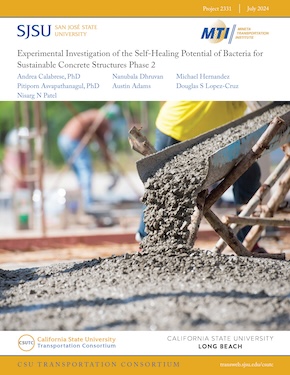- 408-924-7560
- mineta-institute@sjsu.edu
- Donate
Experimental Investigation of the Self-Healing Potential of Bacteria for Sustainable Concrete Structures Phase 2
Concrete is a critical component of so much of the modern construction industry. This material, well known for its versatility, robustness, longevity, and strength, is well-suited for a wide range of structural applications. Nonetheless, the widespread occurrence of cracks in concrete structures, primarily attributed to its limited tensile strength, shrinkage, and overstain, imposes a considerable economic and environmental challenge when it comes to retrofitting these fissures. This study tackles this problem by harnessing bacteria tolerant to high alkaline conditions to enable Microbially Induced Calcium Carbonate Precipitation (MICP) for the self-repair of concrete. This is achieved through an external application method, wherein bacteria are manually and externally applied to the cracks of the concrete surface. This report presents the results of testing three different bacterial species (Bacillus subtilis, Bacillus megaterium, and Sporosarcina pasteurii) to retrofit laboratory-manufactured cracks. The self-repaired groups underwent compressive load-to-failure testing and were compared to a control group (With Crack), revealing a notable increase in compressive strength ranging from 8.59% to 21.61%. The outcomes of the compressive strength tests illustrate the viability of implementing this technique for retrofitting concrete structures, showcasing its environmentally friendly nature and its ability to significantly enhance structural durability. This, in turn, has the potential to impact existing and future developments that incorporate concrete.
ANDREA CALABRESE, PHD, ING, CENG, MICE
Dr. Calabrese joined the California State University, Long Beach’s (CSULB) Civil Engineering and Construction Engineering Management (CECEM) Department as an Assistant Professor in Fall 2017. He obtained a PhD in Construction Engineering with an emphasis in Structural Engineering in 2013. He was a visiting research fellow at the Pacific Earthquake Engineering Research Center (PEER) from 2010–2012 along with having been a postdoctoral researcher of the ReLUIS Consortium at the Italian Network of University Laboratories in Earthquake Engineering from 2013–2014. Dr. Calabrese has worked as a Structural Engineer at Foster & Partners (London) and other firms in Italy for seven years. He has been a registered engineer in Italy since 2009 and a Chartered Engineer (CEng) and Full Member of the Institution of Civil Engineers (MICE) in the UK since 2017. Dr. Calabrese’s current research interests are in the fields of experimental testing, structural dynamics, base isolation, vibration engineering, and the development of novel low-cost devices for the seismic protection of buildings. He has carried out numerous large-scale experimental studies of base isolation systems and energy absorbing devices on the shaking table at the Department of Structural Engineering at the University of Naples in Italy. This work has been instrumental in developing low-cost seismic isolation systems using recycled rubber and flexible reinforcements for the seismic protection of buildings in developing regions. His responsibilities for this research included conceptualization of the work, data analysis, and final editing of the report.
PITIPORN ASVAPATHANAGUL, PHD, PE
Dr. Asvapathanagul is a faculty member in the CECEM Department at CSULB. Her area of competence is Environmental Engineering, primarily bioremediation, biology wastewater treatment, and molecular biology. Examples of her research are bacterial community dynamics in activated sludge, nutrient removal of biological water reclamation processes, biofilms on aeration diffuser membranes, microplastic removal technologies, etc. Dr. Asvapathanagul is also a registered Professional Engineer (PE) in the state of California. Dr. Asvapathanagul employed her expertise in microbiology to advance the accomplishments of the self-healing concrete project.
NISARG N PATEL
Nisarg N Patel is a former Teaching assistant and present Graduate Research Assistant at CSULB’s CECEM Department. He is pursuing an MS in Civil Engineering with a specialization in structural engineering. Nisarg played a pivotal role in various facets of the project, including but not limited to culturing bacteria, preparing food for bacteria, manufacturing concrete test samples, inoculating bacteria into the concrete, and conducting tests on the concrete samples under the supervision of Dr. Asvapathanagul. Additionally, he made significant contributions to drafting the report and meticulously editing its final version.
NANUBALA DHRUVAN
Nanubala Dhruvan is a Graduate Student in the CECEM Department at CSULB pursuing an MS in Civil Engineering, specializing in Structural Engineering. Dhruvan played an important part in various aspects of the project, including manufacturing the concrete test samples, injecting the bacteria into the concrete, and performing tests on the concrete samples under the guidance of Dr. Asvapathanagul. In addition, his contribution also included developing the report’s outline in different phases and also revising it extensively before submission.
AUSTIN ADAMS
Austin Adams is a Graduate Student in the CECEM Department at CSULB pursuing an MS in Civil Engineering, specializing in Structural Engineering. He assisted in the casting and testing of samples, preparing food for the bacteria, and contributing to drafting project reports.
MICHAEL HERNANDEZ
Michael Hernandez is an undergraduate research assistant in CSULB’s CECEM Department where he is pursuing a degree in Mechanical Engineering. Michael actively participated in the project's implementation. His responsibilities encompassed aiding in the manufacturing and testing of samples, as well as extracting results from scratch files. He also contributed to writing the draft and editing the final version of the report.
DOUGLAS LOPEZ-CRUZ
At the time that this report was written, Douglas Lopez-Cruz was a Civil Engineering undergraduate student in his senior year and a research assistant under the supervision of Dr. Asvapathanagul at CSULB. Douglas was tasked with producing comprehensive summaries of scholarly journals and articles about Bacillus subtilis (B-14596); his literature reviews assisted in the preliminary selection process of the bacterium and foods outlined within this report. Throughout the project, he was responsible for and participated in the casting and uncasting of samples; plating, landing, and feeding of bacterium; testing samples; and advising how to improve the quality of the samples produced. He also contributed and participated in the editorial process of this report.
-
Contact Us
San José State University One Washington Square, San Jose, CA 95192 Phone: 408-924-7560 Email: mineta-institute@sjsu.edu






